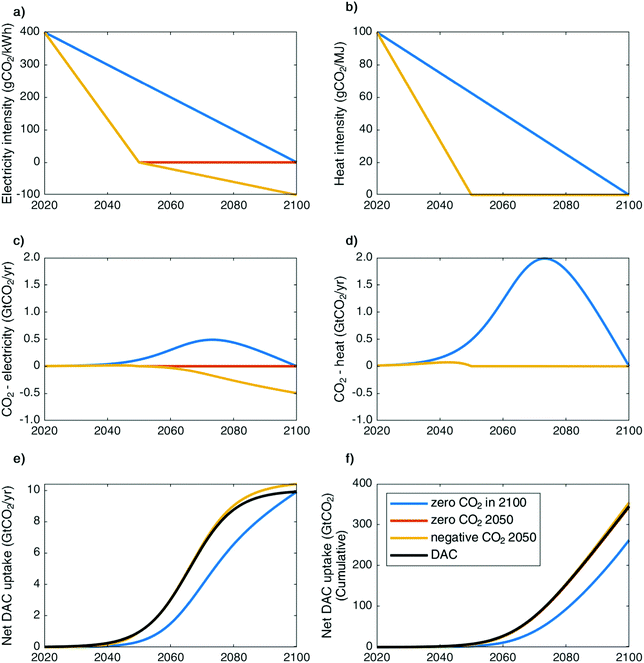 Open Access Article
Open Access ArticleCreative Commons Attribution 3.0 Unported Licence
The mutual dependence of negative emission technologies and energy systems†
Felix
Creutzig
 *ab,
Christian
Breyer
*ab,
Christian
Breyer
 c,
Jérôme
Hilaire
c,
Jérôme
Hilaire
 ad,
Jan
Minx
ae,
Glen P.
Peters
ad,
Jan
Minx
ae,
Glen P.
Peters
 f and
Robert
Socolow
g
f and
Robert
Socolow
g
aMercator Research Institute on Global Commons and Climate Change, Berlin, Germany. E-mail: creutzig@mcc-berlin.net
bChair Sustainability Economics of Human Settlements, Technical University Berlin, Germany
cLappeenranta University of Technology, Lappeenranta, Finland
dPotsdam Institute for Climate Impact Research, Member of the Leibniz Association, PO Box 601203, 14412 Potsdam, Germany
eUniversity of Leeds, UK
fCenter for International Climate and Environmental Research—Oslo, Norway
gMechanical and Aerospace Engineering, Princeton University, USA
First published on 28th February 2019
Abstract
While a rapid decommissioning of fossil fuel technologies deserves priority, most climate stabilization scenarios suggest that negative emission technologies (NETs) are required to keep global warming well below 2 °C. Yet, current discussions on NETs are lacking a distinct energy perspective. Prominent NETs, such as bioenergy with carbon capture and storage (BECCS) and direct air carbon capture and storage (DACCS), will integrate differently into the future energy system, requiring a concerted research effort to determine adequate means of deployment. In this perspective, we discuss the importance of energy per carbon metrics, factors of future cost development, and the dynamic response of NETs in intermittent energy systems. The energy implications of NETs deployed at scale are massive, and NETs may conceivably impact future energy systems substantially. DACCS outperform BECCS in terms of primary energy required per ton of carbon sequestered. For different assumptions, DACCS displays a sequestration efficiency of 75–100%, whereas BECCS displays a sequestration efficiency of 50–90% or less if indirect land use change is included. Carbon dioxide removal costs of DACCS are considerably higher than BECCS, but if DACCS modularity and granularity helps to foster technological learning to <100$ per tCO2, DACCS may remove CO2 at gigaton scale. DACCS also requires two magnitudes less land than BECCS. Designing NET systems that match intermittent renewable energies will be key for stringent climate change mitigation. Our results contribute to an emerging understanding of NETs that is notably different to that derived from scenario modelling.
Broader contextAcademic research suggests that even a rapid decarbonization of energy-related services is likely to be insufficient to keep global heating below 2 °C. In addition to rapid decarbonization, so-called negative emission technologies could suck CO2 out of the atmosphere, and by this help to stabilize the abruptly changing climate. Two key options – bioenergy with carbon capture and storage (BECCS), and direct air capture with carbon storage (DACCS), interact strongly with the energy system. BECCS denotes the combustion of biomass with subsequent carbon sequestration underground and, in some scenarios, may produce 4% of electric, and 30% of non-electric energy in 2100. DACCS technologies enable the filtering of ambient air to then direct CO2 underground, requiring substantial energy, possibly up to 12% of electric and 60% of non-electric energy in 2100. Here, we discuss both technologies in their relation to the energy system. We find that DACCS requires less primary energy per ton CO2 sequestered compared to BECCS; and that a rapid decarbonization of the energy system matters to keep life-cycle emissions of DACCS low. Environmental burden will largely depend on land use requirements, especially for BECCS. We discuss the compatibility of BECCS and DACCS with intermittent renewable energies, a topic that deserves further research. |
To meet the climate goals of the Paris Agreement, humanity would not only need to decarbonize the global economy, but may also need to adopt negative emission technologies (NETs) as an economically attractive mitigation option.1,2 The flexibility in technology choices for energy transitions in line with keeping global heating below 1.5 °C or 2 °C are increasingly limited by a growing geophysical dependence on negative emissions. Hence, which energy technology portfolios can and should be deployed will increasingly depend on the type and scale of NETs deployed, and vice versa. However, a comprehensive understanding of how NETs integrate into the future energy systems in these scenarios is currently lacking.
Current research on NETs has come from two main strands: technology-focused studies that explore specific technical configurations, and integrated assessment models that investigate NETs in the context of global and long-term climate change mitigation.3–5 To understand NETs deployment, detailed energy-system modelling with high temporal, spatial, and technological resolution is crucial to anticipate barriers and initiate a transition pathway6 of the energy system to accommodate NETs.
Here we discuss BECCS and DACCS as two representative NETs that highlight issues related to energy system integration: bioenergy with carbon capture and storage (BECCS), – defined as biomass for energy production associated with captured and stored CO2 emissions – that may provide carbon-negative energy7 and direct air carbon capture and storage (DACCS) – defined as capturing CO2 from ambient air with chemicals with subsequent CO2 storage – that imposes high demands for energy and heat upon the system.8 Other NETs include those that improve the terrestrial carbon stock and that may co-align with ecosystem protection.9 However, the focus of this paper is on NETs that interact with the energy system. Among the questions we address along the way are these: (1) what does large-scale NETs deployment imply for energy production and consumption? (2) How much primary energy is required to remove one ton of carbon? (3) How much net carbon is avoided per unit of carbon sequestered? (4) How could costs of NETs change in a temporally evolving energy system? And (5) what are the implications of NETs for power systems?
Scale of NETs and resulting energy supply and consumption
NETs offer an option of countering our present emissions with future investments.10,11 In fact, to meet current climate goals, the continued growth of emissions indicated by current trends will increasingly lock energy system transformations into pathways that require large-scale NETs.4 While some studies argue that low energy demand and rapid scale-up of renewable energy can deliver ambitious climate mitigation targets without engineered NETs like BECCS and DAC,12,13 most climate policy pathways assessed by the IPCC that limit the temperature increase to below 1.5 °C in 2100 have net zero emissions by mid-century.3,14 While some scenarios can achieve net-zero using afforestation and reforestation only for NETs, the consequent impacts on land can exceed the land impacts of BECCS, and certainly DAC.14 Even if greenhouse gas (GHG) emissions would be cut by 80% by 2050, about 10 Gt CO2 per year would still need to be sequestered by NETs annually from around 2050 onwards to stay below 2 °C global warming. Future worlds that are locked into fossil fuels, and reduce annual GHG emissions only around 2040, may require even 20 Gt CO2 per year removal in 2100 and more.14,15To put the potential scale of NETs into perspective: scaling up 1 Mt per year of any specific NET in 2020 to 1 Gt per year in 2050, an average deployment growth rate of 26% must be sustained for 30 years, so that in 2050 about 200 Mt CO2 per year of new sequestration capacity is added. Solar photovoltaics (PV) has demonstrated the feasibility of even higher growth rates.16,17 Yet, given the lack of incentives for innovation and deployments and the plant-scale nature of many NETs it is unclear whether the PV case translates into similar opportunities for technology-intensive NETs, such as BECCS and DACCS.
This thought experiment also elucidates the relationship in investing into, for example, renewable energy for substituting phased out coal, and investing into NETs. Up until near complete decarbonization any single investment into wind and solar – if associated with decommissioning of coal plants – will be preferable to NETs, because it is cheaper, and also offers improvements in the well-being of many by reducing air pollution and improving health. Nonetheless, it would be too late starting only then to invest into NETs needed to compensate residual emissions from agriculture or aviation, because innovation cycle and technological development takes decades. Hence, there is an argument to advance the rapid phase out of fossil fuels and the market development of NETs simultaneously.
BECCS has been the first NET widely taken up in integrated assessment models4 and shows some appealing characteristics. The biomass that captures the carbon is a versatile energy source. It can be used to produce a variety of final energy carriers, including electricity, transport fuels, and hydrogen. For instance, biofuels can, in principle, enable low-carbon aviation or freight transport, if other mitigation options fail.18 BECCS has been the main and often single NET used in integrated assessment models (IAMs) so far, playing a central role in mitigation scenarios.19 This evidence shows that BECCS can impact the energy system significantly: biomass requirements for BECCS can reach up to 190 EJ per year in 2050 and 300 EJ per year in 2100 in 2 °C scenarios, and 300 EJ per year in 2050 and 400 EJ per year in 2100 in some 1.5 °C scenarios.20,21 Such large bioenergy deployments require very large commitments of land and may come with significant social impacts (e.g. food prices) and environmental impacts (e.g., land and water impacts).22–24 However, some 2 °C scenarios allow lower bioenergy deployments, as low as 100 EJ per year.3,19,25 This may even be true for some 1.5 °C scenarios.12,26,27
DACCS stands for technologies that extract CO2 directly from air with chemicals. It has been evaluated in several studies using many different assumptions.8,28–32 DACCS requires significant amounts of energy to move the air and to cycle the sorbent, and there is substantial embedded energy in the physical structures.8 In comparison to BECCS, DACCS is also seen by some – acknowledging the existing void of research on DACCS (scale-dependent) side-effects3 – as a relatively environmentally benign option for large-scale carbon dioxide removal, depending on how electricity and heat inputs are produced.33 It may enable considerable flexibility in siting near energy sources or storage sites. Both technologies are conceptually introduced in Fig. 1.
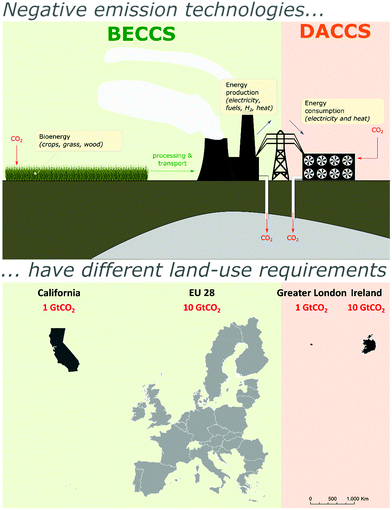 | ||
| Fig. 1 Overview of BECCS and DACCS. With BECCS, CO2 is absorbed by photosynthesis in plants. CO2 is then captured after combustion, and then stored underground. With DACCS, CO2 is captured from ambient air with chemical absorption before being stored underground. DACCS requires energy input, while BECCS produces energy. BECCS is highly land intensive. Land use requirements are illustrative but crucially depend on yields, technology, and soil productivity, resulting in a large range of land use estimates. For example, 10 Gt CO2 removal via BECCS might require 5–29% of the world's productive land, with lower values achieved with the use of the most productive land.22,24,34–36 | ||
A recent study uses an integrated assessment model, MERGE-ETL, to investigate BECCS and DACCS jointly. It shows that both technologies heavily impact energy production and consumption (Fig. 2).37 The two mitigation scenarios depicted in Fig. 2 illustrate the high rates of end-use energy produced by BECCS and consumed by DACCS in 2100 to keep the goals of the Paris Agreement within reach. In the 2 °C scenario, 450 EJ per year of electric energy and 400 EJ per year of non-electric energy is consumed and produced in 2100. For electricity, 4% of production is from BECCS and 9% of consumption is for DACCS, for non-electric, 30% of production is BECCS and 30% consumption is DACCS. Over the 21st century, a total of 300 Gt CO2 is stored using DACCS and 600 Gt CO2 for BECCS.
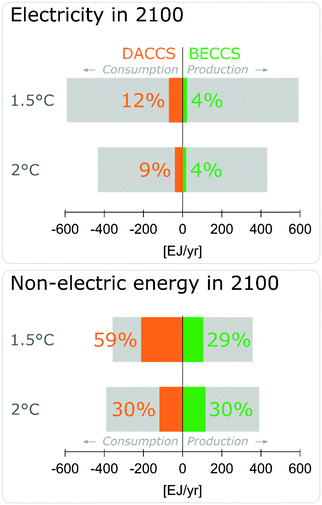 | ||
| Fig. 2 BECCS and DACCS could play prominent roles in the future energy system for generation and load. The 2 °C and 1.5 °C scenario data used in this figure are taken from ref. 37 (which relies on the MERGE-ETL model, investigating BECCS and DACCS but not any other NET); characteristics may differ in other models. Data are shown for the year 2100. The amount of energy required to build the BECCS and DACCS infrastructures as well as that necessary to sustain biomass production and the transport of bioenergy are not considered in this figure but are considered small relative to the values presented here. | ||
Electricity consumption and production is considerably higher in the 1.5 °C degree scenario, and non-electric energy consumption is lower. With 600 EJ per year electric energy 12% is consumed by DACCS, 4% produced by BECCS; of 350 EJ per year non-electric energy 59% is consumed by DACCS and 29% produced by BECCS. Cumulative CDR over the 21st century is 600 Gt CO2 for both BECCS and DACCS; hence, the energy footprint as presented in this model runs is higher for DACCS than for BECCS. The carbon prices in 2100 are about $US(2010) 1000 per tCO2 in the 2 °C scenario (66% chance) and about $US(2010) 4200 per tCO2 in the 1.5 °C scenario (50% chance). In both scenarios the non-electricity part of the energy system (here liquid fuels, hydrogen and heat) is more affected by NETs than electricity. It is hence important to better understand the energy requirements for both BECCS and DACCS.
Energy per removed carbon
A crucial metric involves the primary energy input per removed ton of CO2 for BECCS and DACCS, and the useful energy output for BECCS. In the model (MERGE-ETL) of Fig. 2,37 DACCS requires 7.5–8 GJ per tCO2 (Table 1); here, the primary energy associated with electricity is quantified by its thermal value (1 MW h = 3.6 GJ) Another integrated assessment model, WITCH, assumes 9.9 GJ per tCO2 for DACCS, relying on the values calculated in the DAC assessment of the American Physical Society,8 falling well within the range of 6.7–22.7 GJ per tCO2 reported in an overview study (Table 1).22,30–32,35 The studies fall into two groups, depending on the temperature required to regenerate the sorbent: the APS assessment8,29 explores aqueous solutions of low-cost sorbents, with (desorption typically working at 900 °C) and estimate 9.9 GJ per tCO2; papers bearing on work by Climeworks, Global Thermostat and Antecy rely on solid sorbents (desorption typically working at 70–95 °C), reporting a slightly lower range of values of 4.7 to 10.0 GJ per tCO2. The most recent assessment of direct air capture and other negative emission technologies, performing detailed bottom-up analysis, also suggests that the solid sorbent approach is energetically preferable.38 All of these values are far above the thermodynamic minimum for raising the CO2 concentration, which is only about 0.5 GJ per tCO2.8| BECCS [GJ per tCO2] | Source | DACCS [GJ per tCO2] | Source | |
|---|---|---|---|---|
| Integrated assessment models | 14 [5.5–23] PE | 212 model runs from 8 models (Fig. S1, ESI) from the AMPERE and LIMITS database39,40 | Liquid: −(7.5–8) | 37, 41 and 42 |
| E: 3.0 | −9.9 (E: 1.8; H: 8.1) | |||
| Bottom-up modelling | E: −(1.9)–3.1 | 35 (accounts for energy input) | Liquid: −(6.7–22.7) | 22 and 29 |
| E w LUC: −(2.5)–2.3 | 43 (does not account for energy input) | Liquid: E: −(1.8; H: 8.1) | 44 | |
| PE: 12.1, E: 0.21 | Liquid: E: −(1.3; H: 5.3) | |||
| National Academy of Science | Liquid: −(8.4–12.4) (E: 0.7–1.7; H: 7.7–10.7) | 38 | ||
| Solid: −(4.0–5.9) (E: 0.6–1.1; H: 3.4–4.8) | ||||
| Industry sources | Climeworks: solid | 32 | ||
| E: −(0.7–1.1) | ||||
| H: −(5.4–7.2) | ||||
| T: −(6.1–8.3) | ||||
| Global thermostat: solid | 30 | |||
| E: −(0.5–0.9) | ||||
| H: −(4.2–5.1) | ||||
| T: −(4.7–6.0) | ||||
| Antecy: solid | ||||
| E: −2.5 | ||||
| H: −7.5 | ||||
| T: −10.0 | ||||
| Range: −(4.7–10.0) | 31 | |||
| Thermodynamic minimum | −(0.45–0.5) GJ per tCO2 | 8 | ||
| Land for 10 Gt CO2 sequestration capacity | 400–2400 Mha | 22, 24, 35 and 36 | 1 Mha | 8 and 45 |
High-temperature systems are likely to be powered by fossil fuel combustion. (Concentrated solar power may be an alternative but has so far been investigated only for lower-temperature settings28 or for CO2-to-fuel settings.46) In contrast, the low-temperature adsorption process could match well with renewable energy input. Low temperature systems can be driven with heat pumps that themselves operate on renewable energy sources, or by the heat co-generated with solar electricity. Heat pumps convert heat from the ambient to higher temperature levels up to 65 or 85 °C driven by electricity. Heating rods can further increase the heat to the desired level. An average coefficient of performance (COP) of 3.0 is assumed for converting ambient heat to the required level of low temperature DAC systems, which require 70 to 95 °C. With a co-efficient of performance of 3.0 for a heat pump, each unit of electric energy translates into three times the amount of thermal energy. Taking an exergy perspective (maximal useful work), with heat pumps, the three cited private DACCS systems of Table 1 could operate at 2.4–7.5 GJ per tCO2, an efficiency gain of 25–49%. An alternative would be to obtain the (stored) heat for DACCS from concentrated solar power and heat stored in molten salt. However, a model of DACCS in the Maghreb region found PV with heat pumps an economically attractive option.45
This insights points to the importance of focusing on exergy for NETs analysis.
BECCS is driven by primary energy in biomass. Data bases of integrated assessment studies suggest a median value of 14 GJ per tCO2 for the primary energy in the biomass divided by the CO2 captured, with a range from 5.5–23 GJ per tCO2 (Fig. S1, ESI†). The modeling results of Fig. 2, based on MERGE-ETL, assume as median value 14.5 GJ per tCO2, and calculate 3.0 GJ per tCO2 as electricity output, corresponding to a conversion efficiency from biomass to electricity of 21%.
These results can be compared with a study featuring detailed bottom-up modelling, which finds a range from negative −1.9 GJ per tCO2 to positive 3.1 GJ per tCO2 for the electricity output from BECCS with Miscanthus and switchgrass as biomass. A typical conversion efficiency from biomass to electricity is 14.5%, and the energy in primary biomass per carbon dioxide sequestered is about 17.9 GJ per tCO2 variation results from assumptions on for example biomass transport and processing.35 Considering direct and indirect land use change, leading to reduced net sequestration, lowers the electricity yield further; the range is now from −2.5 to +2.3 GJ per tCO2. BECCS and DACCS energy factors are systematically compared in Table 1.
Our analysis suggest that modeling studies overestimate energy yields from BECCS by 40% or more by underestimating or ignoring the energy input required for biomass-based fuel provisioning, such as the embodied energy in chemicals and seeds, the direct energy use for farm operation, and the direct and indirect energy use in biomass processing.35 Some data from industrial studies on solid sorbents also indicate that modelling might overestimate the energy input required for DACCS (Table 1).
A high-level result from our analysis is that DACCS outperform BECCS in terms of primary energy required per ton of carbon sequestered (Fig. 3). For illustration, consider a situation where 100 EJ primary energy is available for NETs. Then the results of the IAM example for BECCS above37 would translate into 6.9 Gt CO2 sequestration and 21 EJ electricity (the range is 4.5 to 8.5 Gt CO2/100 EJ with lower values in sequestration providing more useful energy, and higher values in sequestration less useful energy47) (for full range see Fig. S1, ESI†). The more detailed bottom-up model,35 accounting for more processing steps, would suggest outcomes of 5.6 Gt CO2 and 14.5 EJ. If also land use change emissions occur, the net results would change to 4.2 Gt CO2 and 10.8 EJ. This contrast with DACCS, where 100 EJ input energy translate into 10.1 Gt CO2 in the case of IAM models with APS assumptions or possibly up to 20 Gt CO2 in the case of low-temperature DAC assumptions (Fig. 3). Assuming a one year energy payback period for PV, and a lifetime of PV modules of 20–33 years, a penalty of 3–5% might be applied to the DACCS values, while not changing the estimated order of magnitude.
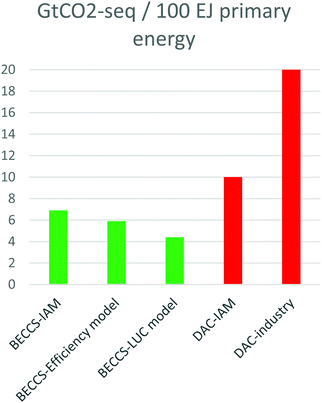 | ||
| Fig. 3 Amount of CO2 sequestered per 100 EJ primary energy input. BECCS-IAM: values used in IAM model MERGE-ETL.37 BECCS-efficiency model: bottom-up model.35 BECCS-LUC model: same bottom-up mode35 but with land-use change emissions. DAC-IAM: value used in IAMs.37,41 DAC-industry: value from studies relying on solid sorbents. | ||
Avoided carbon
Another crucial metric is net avoided carbon. We consider three cases: BECCS; DACCS with solid sorbents powered by PV and battery storage; and DACCS with liquid sorbent powered by electricity with average representative carbon intensity and gas plus CCS for heating.The benchmarking APS study on DACCS with liquid sorbents accounts for the CO2 intensity of the required inputs of electricity and high-temperature heat.8 To demonstrate the importance of assumptions about these energy inputs, the study works out a particular case where a high-CO2 strategy is adopted for electricity but a low-CO2 strategy is adopted for heat. Specifically, grid electricity is used to power fans and pumps at a time when the decarbonization of electricity has not advanced very far, but heat is provided by natural gas burned on-site, with the resulting CO2 co-sequestered with the CO2 removed from the air. This case results in the net sequestration of 70% of the CO2 removed from the air. To further demonstrate the relevance of the carbon intensity of the process energy required to power DACCS, we run three scenarios for a particular DACCS adoption rate and assumed constants inputs of electricity and heat, but differing in the rate of decarbonization: (A) linear decarbonization of electricity and heat until 2100, (B) linear decarbonization of electricity and heat until 2050, followed by zero emissions until 2100; and (C) the same decarbonization until 2050 as in the first case, but further decarbonization of the electricity system, into negative territory (relying on BECCS), between 2050 and 2100 (Fig. 4 and Fig. S2, ESI†). DACCS scales up with a logistic function, having its inflection point in 2066 at 5 Gt CO2 per year and saturating at 10 Gt CO2 per year, resulting in 345 Gt CO2 of CO2 removal from the air by 2100. The assumed electricity and heat inputs per ton of CO2 removed are 500 kW h (1.8 GJ) and 8.1 GJ, respectively, typical for liquid absorbents; in our case, emissions from heat are 4 times higher than from electricity. The saturation level of 10 Gt CO2 per year in 2100 was chosen to reflect a rate of carbon dioxide removal required in many climate stabilization scenarios.14,48
As installed DACCS capacity is set to 1 Gt CO2 per year in 2050, the rapid decarbonization trajectories in scenarios B and C result in small process-based CO2 over the century (1.2 Gt CO2 in for scenario B, and 9.5 Gt CO2 capture in scenario C cumulatively until 2100), compared with 345 Gt CO2 removed from the air. In contrast, for scenario A, about a quarter (24.1%) of the CO2 sequestered will be cancelled by process-energy emissions (83 Gt CO2). For comparison, a full life-cycle model of a liquid sorbent systems, also accounting for DACCS infrastructure, finds that 38% of sequestered emissions are emitted (not considering decarbonization scenarios), and that emission loss can be limited to 7% if optimized, including energy sourcing by photovoltaics.49
Any NET implemented over the course of this century with the decarbonization trajectories of scenario A will raise a similar set of issues. First, NETs must sequester additional tens of gigatons of CO2 to compensate for continued emissions from fossil fuels. Second, the energy return of investments (EROI) of fossil fuels decreases dramatically when fossil energy inputs to an NET are included in the NET's energy system (i.e. for each unit of delivered energy originating from fossil fuels, one has not only account the fossil fuel input for this delivered energy but also the energy to power DACCS). Third, the NET is accompanied by non-GHG-related environmental degradation from fossil fuels, including air pollution and the impact of mining. In this light, DACCS appears to be a NET that becomes much more attractive for scenarios B and C than scenario A. A switch of energy systems towards low-carbon sources, such as solar and wind, hence has priority over the rapid introduction of NETs.
For the solid sorbent, we assume that electricity is generated by photovoltaics, and that heat is provided by geothermal power with COP of 3. We choose E = 1 GJ per tCO2, and H = 4.8 GJ per tCO2, at the upper end of the range indicated in the most recent authoritative assessment.38 This results in a requirement of total electricity of 2.6 GJ per tCO2. Median life-cycle emissions from PV are estimated at 48 gCO2 e per kW per h.48 We assume that half of them can avoided by cleaner provisioning of energy input for PV production until 2100 (linear reduction), while the other half is due to albedo and cannot be avoided.50 DACCS scales up like in Fig. 4. This results in 16 Gt CO2 equivalent emitted until 2100 for 345 Gt CO2 sequestered (Table 2).
| Technology | Scenario | Gt CO2 cumulatively emitted until 2100 | % of gross sequestration |
|---|---|---|---|
| DACCS liquid sorbent and APS specifications | Scenario A | 83 | 24.1 |
| Scenario B | 1.2 | 0.4 | |
| Scenario C | −9.5 | −2.8 | |
| DACCS solid sorbent | PV for electricity and geothermal for heat | 16 | 4.6 |
| BECCS | Scenario switchgrass w/o ILUC | 35 | 10 |
| Scenario forest biomass w/o ILUC | 172 | 50 |
For BECCS, we rely on the reported net and gross sequestered emissions by BECCS systems assessed in Fig. 3 of ref. 25, resulting in notable net emissions at 10–50% of CO2 sequestered. Emissions from indirect land use change (ILUC) are not included and could potentially be highly relevant,51,52 also for the case of switchgrass.53 To our best understanding ILUC has not been estimated for BECCS systems. In Integrated Assessment Models, ILUC are commonly assumed to be very low due to a global carbon price on land use, an assumption that some of us consider highly unrealistic.24
In summary, DACCS system have less net CO2 emissions associated with their provisioning systems displaying a sequestration efficiency of 75–100%, compared to BECCS displaying a sequestration efficiency of 50–90% with lower values possible. Also for DACCS design is important to improve the overall sequestration efficiency.
Costs of NETs in a temporally evolving energy system
NETs all have substantial costs and some sort of carbon pricing will be required to incentivize the uptake of NETs at the relevant scale.5 BECCS can rely on established routes of fuel combustion coupled with capture and storage technologies with estimated costs of $100–200 per tCO2 sequestered4 relative to required carbon prices in 2 °C or 1.5 °C scenarios (about $100 per tCO2 and $500 per tCO2, respectively, in 2050; $1000 per tCO2 and $4000 per tCO2, respectively, in 2100). In contrast, DACCS requires substantial material, technological and energy input. Typical estimates of future costs range from $100–300 per tCO2 in 2050,4 and below that with high technological learning rates.5,45,54 The National Academy of Science estimates DACCS with solid sorbents to be most cost-competitive if powered with low-carbon energy from renewables or nuclear at $90–$250 per tCO2,38 similar to a recent detailed costing study investigating an industrial process.44 The current lower perceived cost of BECCS is a distinct advantage relative to DACCS and seemingly motivated predominant modelling of BECCS in climate mitigation scenarios.However, technological development and resource input considerations may modify this calculus (Tables 1 and 2). Technological learning is relevant for both technologies. For BECCS the highest efficiency in the combustion process is achieved in large thermal power plants, leaving little potential of improvement by modular design. Biomass production would benefit from increases in yields and improvements in harvesting and transport, which would reduce the very high land requirements of BECCS (Fig. 1 and Table 2). In contrast, DACCS is a modular technology that may be implemented in diverse setting and hence is most likely subject to considerable cost reductions.5,55
Land constraints also favor DACCS over BECCS, dramatically. The spacing of DAC contactors requires consideration of the replenishment of the CO2 in the air downstream and to the sides, analogous to the spacing of wind turbines to avoid negative effects of wakes; this is an understudied area. In one hypothetical layout, DAC requires only about 1 Mha for 10 Gt CO2 per year for air contactors8,45 By contrast, BECCS requires 400–2400 Mha land.22,24,35,36 The location of both DACCS and BECCS facilities will both be limited by access to CO2 storage infrastructure, biomass supply (BECCS), and energy supply (DACCS). Of these constraints, the bioenergy supply is probably most significant.56 BECCS competes with other land uses, such as food production, and biodiversity protection.34 Biomass can be produced in biodiversity-rich settings but only at low productivity.57 Especially the ecological costs, if properly priced in, could prohibit large-scale reliance on BECCS.23,24 The land dynamics imply that marginal prices for carbon dioxide removal with increasing adoption will likely increase for BECCS (even without considering ecological costs, marginal costs of biomass increase 4-fold with increasing biomass demand38). As a result, BECCS costs would initially fall as the technology matures, and rise again as underlying land scarcity becomes increasingly relevant. Plausibly, all bioenergy that can be sourced sustainably (about 100 EJ3,25 primary energy) could be allocated to BECCS, so that about 4.2–5.6 Gt CO2 per year could be sequestered (reflecting losses in energy and CO2 in along different steps in the process).
A further issue is NET accountability and verification of the sequestered CO2. Ignored in cost-based modelling of NETs, accountability is an important issue from an investor's perspective, requiring a degree of certainty in amount of CO2 removed from the atmosphere. DACCS can offer high accountability as all CO2 is captured on site and can be easily measured. In contrast, BECCS is caught in a complex web of accounting issues that arise from land use management.25,51,58,59 For many feedstocks, sequestration efficiency of BECCS will be too low to make BECCS attractive or viable in any energy system configuration. There is no agreement on boundaries of analysis, and hence the sequestration efficiency and resulting monetary value is contested. It is hence not only a question of technological development to decrease bioenergy lifecycle emissions, but also of regulation to ensure strict system boundaries and reliable accounting of bioenergy emissions. Carbon accounting risks are likely to increase the marginal costs of BECCS furthers.
Both BECCS and DACCS suffer from the same risks associated with leakage of carbon from storage sites. Leakage it is not widely perceived as a major hurdle to safe and permanent storage,3 but require enormous investments and vast improvements in specific research and design to scale up underground storage at gigaton scale.38Table 3 summarizes the various factors that determine the viability of BECCS and DACCS.
Four future developments, two each for BECCS and DACCS, provide a qualitative sense of some of the issues that will determine their rate of introduction into the global economy (Fig. 5). In the first story, labeled YIELDS, high biomass yields and algae options offer a relatively low land footprint, enabling large-scale bioenergy adoption with moderate impact on food and biodiversity. This story is commonly told in integrated assessment models, and is supported by low costs that have been demonstrated for BECCS with ethanol fermentation (US$20 to 175 per tCO2) and for favorable location/logistics.3 High yields of 3–50 t ha−1 year−1 have also been demonstrated in test trials for bamboo and Miscanthus.60
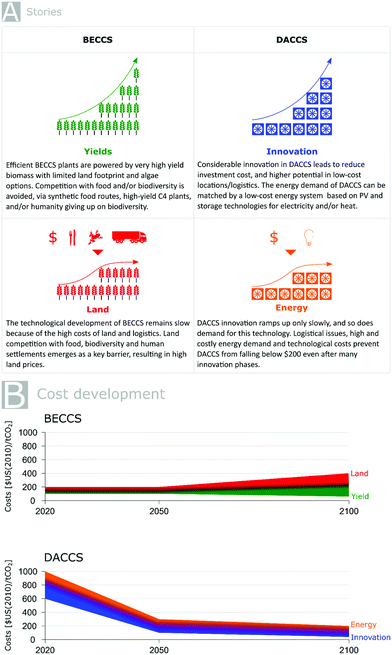 | ||
| Fig. 5 Plausible cost development and CO2 removal, illustrating the effects of different constraining factors and technological options. Depending on technological learning and resource constraints, both BECCS and DACCS could develop into widely diverging futures. (A) Story description. (B) Associated cost development. Cost assumption for 2050 are taken from the review and expert judgement in ref. 4. | ||
In the second story, labeled LAND, land competition with food, biodiversity and human settlements emerges as key barrier, requiring paying high prices for input factor of land. The resource dependence on land also puts fundamental limits on technological learning, as logistics and land requirements provide a cost floor to biomass sourcing. In fact, the global dynamics of land use change indicate a scarcity of land availability for bioenergy,23,34 and problematic competition with food.61 Perhaps even more problematically, land use pressures decrease biodiversity worldwide, more than they compromise food production,62 and bioenergy at massive scales is likely to accelerate the anthropogenic mass extinction.63 Yield improvements of bioenergy plants may offer a way out, but those improvements may be difficult to scale as land, climate and water constrain average potential, and ecological studies suggest that yields in test settings in highly favorable conditions have few implications for average yields achievable for large amount of biomass production.24
In the third story, labeled ENERGY, DAC demand and associated innovation ramps up only slowly; both logistical issues and high and costly energy demand result in a DAC cost that does not fall below a plateau at $200 per tCO2 even after many innovation options taken. Indeed, thermodynamic limits and associated energy constraints have been argued to limit cost declines of DAC.64 Logistics of CO2 transport facility remains unexplored and could become part of the cost floor.
In the fourth story, labeled INNOVATION, considerable innovation in DACCS leads to lower specific investment cost, and potential in low-cost locations/logistics; energy demand of DAC can be significantly lowered and matched with a low-cost system based on PV and storage technologies. The electricity component could be delivered by PV and battery electric storage and the heat component either by geothermal energy and heat pumps driven by electricity or by other heat storage, e.g. in stones or molten sand, possibly coupled with concentrated solar power.65 This story is plausible as DAC is modular and scalable, enabling possibly technological learning similar to comparable technologies, such as electrolysers, battery systems and reverse osmosis desalination plants.66,67 DACCS cost have been modeled to decline well below $100 per tCO254,55,68 for example in combination with low-cost PV, batteries and heat pumps in 2050 in favorable locations.45
Implications for power systems
The rate of energy system decarbonization has important consequences for the scale of NET adoption. Slower decarbonization of the energy system requires increased adoption of NETs to achieve the same target, for two reasons. First, less decarbonization requires more NETs to compensate for higher emissions. Second, less decarbonization puts a carbon efficiency penalty on NETs – particularly in early stages of adoption (e.g. when heating for adsorption in DACCS is gas powered). A rapid decarbonization reduces hence both the dependency on NETs to stay below desired temperatures and their efficiency.DACCS has high capital costs and high energy input, and would therefore benefit from full utilization (operating close to base load conditions) and low energy prices. Energy systems based on nuclear, coal or gas with CCS, and renewable energy systems with storage capacity would be candidates to deliver low-carbon electricity with close to constant output. Recent studies suggest that PV/battery systems and electrification of other sectors could act as the backbone of a future energy system,16,69,70 even as marginal costs increase as 100% penetration is approached. In contrast, current trends in centralized energy systems (such as traditional nuclear) demonstrate cost increases.71 Biomass and/or CCS based systems also show lower energy-return-on-investments than solar and wind, resulting in lower net energy availability.72 In some climate mitigation scenarios, NETs operate concurrently with low-cost fossil fuels (oil and gas).15 DACCS configurations could be fired by thermal energy from gas or by electricity from a grid that is only partially decarbonized. However, in this case net sequestration efficiency, which includes the GHG emissions generated by power and heat production, declines rapidly as the CO2 intensity of input energy increases. Importantly, while renewable-based electricity cost increases with load hours – reflecting the challenge to manage variable availability of renewable energy sources – efficiency gains at full utilization of DACCS facilities compensate for these higher costs.73
The dispatch load factor of a BECCS system is likely to be low in an energy system based on renewable energy74 that is characterized by frequent surplus electricity (e.g., excess solar power at noon). In that case, BECCS systems might be heavily underutilized in terms of electricity generation, and recuperation of their capital costs becomes more challenging. In addition, in BECCS facilities, improved electricity generation is subject to a trade-off with reduced CO2 sequestration per kW h.75 As a result, lower capital costs and less efficient BECCS facilities may be preferable, operating at constant rates of input, removing CO2 from the atmosphere at constant rates, and dispatching electricity on an as-needed basis. BECCS systems that generate fuel instead of electricity may be valuable in decarbonizing sectors that are otherwise very costly, such as aviation, but generate very few negative emissions. If PV-based systems generate cheap energy in such abundance as to require only modest contributions from other energy sources, the energy component of BECCS may become increasingly irrelevant, and technology can focus on safely sequestering biomass below ground, essentially turning BECCS into BCCS – biomass carbon capture and storage.
Multiple metrics required to steer NETs towards energy system integration
We call for research from the energy systems community to sharpen the understanding of the requirements for negative emission technologies to operate in different energy systems (Fig. 6). We suggest that researchers should keep track of some key metrics that underlie NET costs: utilization rate, sequestration efficiency and reliability.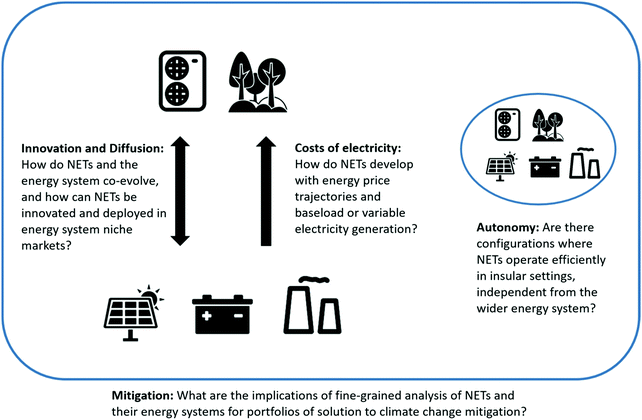 | ||
| Fig. 6 Emerging questions at the interface between energy system research and negative emission technologies. | ||
First, utilization rate and load hours of NET facilities crucially depend on the energy system, and they determine the amortization of capital costs and hence economic feasibility. However, the parameterization of these relationships is currently not known. To recover the high capital costs of both technologies, it is desirable that they can be run close to base load, generating income from sequestered CO2.43 It could be interesting to combine the energy output of BECCS with energy input for DACCS. Both NETs could also be treated as isolated facilities disconnected from the wider energy system, particularly in the case of DACCS or where BECCS focusses purely on sequestration and energy produced is treated as a low-value byproduct.
Second, sequestration efficiency and reliability in the entire life-cycle will determine the financial viability of NETs in established carbon markets. DACCS facilities require considerable energy input. If this input is generated from fossil fuels, the sequestration efficiency of DACCS is reduced rapidly, in most circumstances rendering DAC inviable. In a renewable-electricity-based energy system, DACCS would sequester CO2 efficiently with straightforward verification and high reliability, improving the economic case for DACCS. For BECCS the case is different. BECCS sequestration efficiency is independent from the carbon intensity of electricity and the rest of the energy system. Instead, the sequestration efficiency depends strongly on the consequential life-cycle emissions of the feedstock, including the indirect land use implications of converting land to biomass production for energy25,51 and the efficiency of the BECCS plants.75
We argue that as BECCS is scaled up, its costs will experience significant upward cost pressures from very high land requirements, carbon sequestration verification problems; also the limited potential for technological learning severely constrains a BECCS-dominated NET-energy system. DACCS may have greater potential if real-world learning and adoption advances rapidly. DACCS would also profit from a low-cost low-carbon energy system (e.g. based mostly or entirely on renewable sources coupled with low-cost battery and/or heat storage). This view contrasts with the messages from integrated assessment models, and more detailed fine-grained energy system analysis is required to resolve these conflicts.
Our discussion points to crucial dimensions of NETs in different plausible energy systems. Further research that for example emphasizes high spatial and temporal resolutions of power systems should further elucidate the dynamic landscape of NETs in energy systems. Negative-emission technologies emerges as a crucial cornerstone of forward-looking energy systems research.
Conflicts of interest
There are no conflicts of interest to declare.References
- J. Rogelj, G. Luderer, R. C. Pietzcker, E. Kriegler, M. Schaeffer, V. Krey and K. Riahi, Nat. Clim. Change, 2015, 5, 519–527 CrossRef.
- E. Kriegler, O. Edenhofer, L. Reuster, G. Luderer and D. Klein, Clim. Change, 2013, 118, 45–57 CrossRef CAS.
- S. Fuss, W. F. Lamb, M. W. Callaghan, J. Hilaire, F. Creutzig, T. Amann, T. Beringer, W. de Oliveira Garcia, J. Hartmann, T. Khanna, G. Luderer, G. F. Nemet, J. Rogelj, P. Smith, M. del Mar Zamora and J. C. Minx, Environ. Res. Lett., 2018, 13, 063002 CrossRef.
- J. C. Minx, W. F. Lamb, M. W. Callaghan, S. Fuss, J. Hilaire, D. Lenzi, G. Nemet, F. Creutzig, T. Amann, T. Beringer, W. de Oliveira Garcia, J. Hartmann, T. Khanna, G. Luderer, G. F. Nemet, J. Rogelj, S. Rogers, P. Smith and M. del Mar Zamora, Environ. Res. Lett., 2018, 13, 063001 CrossRef.
- G. F. Nemet, M. W. Callaghan, F. Creuzig, S. Fuss, J. Hartmann, J. Hilaire, W. F. Lamb, J. C. Minx, S. Rogers and P. Smith, Environ. Res. Lett., 2018, 13, 063003 CrossRef.
- M. Child and C. Breyer, Energy Policy, 2017, 107, 11–26 CrossRef.
- D. L. Sanchez and D. M. Kammen, Nat. Energy, 2016, 1, nenergy20152 Search PubMed.
- R. Socolow, M. Desmond, R. Aines, J. Blackstock, O. Bolland, T. Kaarsberg, N. Lewis, M. Mazzotti, A. Pfeffer and K. Sawyer, et al., A Technology Assessment for the APS Panel on Public Affairs, 2011 Search PubMed.
- B. W. Griscom, J. Adams, P. W. Ellis, R. A. Houghton, G. Lomax, D. A. Miteva, W. H. Schlesinger, D. Shoch, J. V. Siikamäki and P. Smith, Proc. Natl. Acad. Sci. U. S. A., 2017, 114, 11645–11650 CrossRef CAS PubMed.
- S. Fuss, J. G. Canadell, G. P. Peters, M. Tavoni, R. M. Andrew, P. Ciais, R. B. Jackson, C. D. Jones, F. Kraxner, N. Nakicenovic, C. Le Quere, M. Raupach, A. Sharifi, P. Smith and Y. Yamagata, Nat. Clim. Change, 2014, 850–853 CrossRef CAS.
- K. Anderson and G. Peters, Science, 2016, 354, 182–183 CrossRef CAS PubMed.
- A. Grubler, C. Wilson, N. Bento, B. Boza-Kiss, V. Krey, D. L. McCollum, N. D. Rao, K. Riahi, J. Rogelj and S. Stercke, Nat. Energy, 2018, 3, 515 CrossRef.
- Achieving the Paris Climate Agreement Goals: Global and Regional 100% Renewable Energy Scenarios with Non-energy GHG Pathways for +1.5 °C and +2 °C, ed. S. Teske, Springer International Publishing, 2019 Search PubMed.
- IPCC, Global warming of 1.5 °C. An IPCC special report on the impacts of global warming of 1.5 °C above pre-industrial levels and related global greenhouse gas emission pathways, in the context of strengthening the global response to the threat of climate change, 2018 Search PubMed.
- E. Kriegler, N. Bauer, A. Popp, F. Humpenöder, M. Leimbach, J. Strefler, L. Baumstark, B. L. Bodirsky, J. Hilaire, D. Klein, I. Mouratiadou, I. Weindl, C. Bertram, J.-P. Dietrich, G. Luderer, M. Pehl, R. Pietzcker, F. Piontek, H. Lotze-Campen, A. Biewald, M. Bonsch, A. Giannousakis, U. Kreidenweis, C. Müller, S. Rolinski, A. Schultes, J. Schwanitz, M. Stevanovic, K. Calvin, J. Emmerling, S. Fujimori and O. Edenhofer, Global Environ. Change, 2017, 42, 297–315 CrossRef.
- F. Creutzig, P. Agoston, J. C. Goldschmidt, G. Luderer, G. Nemet and R. Pietzcker, Nat. Energy, 2017, 2, 17140 CrossRef.
- N. M. Haegel, R. Margolis, T. Buonassisi, D. Feldman, A. Froitzheim, R. Garabedian, M. Green, S. Glunz, H.-M. Henning, B. Holder, I. Kaizuka, B. Kroposki, K. Matsubara, S. Niki, K. Sakurai, R. A. Schindler, W. Tumas, E. R. Weber, G. Wilson, M. Woodhouse and S. Kurtz, Science, 2017, 356, 141–143 CrossRef CAS PubMed.
- O. Edenhofer, K. Seyboth, F. Creutzig and S. Schlömer, Annu. Rev. Environ. Resour., 2013, 38, 169–200 CrossRef.
- P. Smith, M. Bustamante, H. Ahammad, H. Clark, H. Dong, E. A. Elsiddig, H. Haberl, R. Harper, J. House, M. Jafari, O. Masera, C. Mbow, N. H. Ravindranath, C. W. Rice, C. Robledo Abad, A. Romanovskaya, F. Sperling and F. Tubiello, in Climate Change 2014: Mitigation of Climate Change. Contribution of Working Group III to the Fifth Assessment Report of the Intergovernmental Panel on Climate Change, ed. O. Edenhofer, R. Pichs-Madruga, Y. Sokona, E. Farahani, S. Kadner, K. Seyboth, A. Adler, I. Baum, S. Brunner, P. Eickemeier, B. Kriemann, J. Savolainen, S. Schlömer, C. von Stechow, T. Zwickel and J. C. Minx, Cambridge University Press, Cambridge, United Kingdom and New York, NY, USA, 2014 Search PubMed.
- L. Clarke, K. Jiang, K. Akimoto, M. Babiker, G. Blanford, K. Fisher-Vanden, J.-C. Hourcade, V. Krey, E. Kriegler, A. Löschel, D. McCollum, S. Paltsev, S. Rose, P. R. Shukla, M. Tavoni, B. van der Zwaan and D. P. van Vuuren, in Climate Change 2014: Mitigation of Climate Change. Contribution of Working Group III to the Fifth Assessment Report of the Intergovernmental Panel on Climate Change, ed. O. Edenhofer, R. Pichs-Madruga, Y. Sokona, E. Farahani, S. Kadner, K. Seyboth, A. Adler, I. Baum, S. Brunner, P. Eickemeier, B. Kriemann, J. Savolainen, S. Schlömer, C. von Stechow, T. Zwickel and J. C. Minx, Cambridge University Press, Cambridge, United Kingdom and New York, NY, USA, 2014 Search PubMed.
- J. Rogelj, A. Popp, K. V. Calvin, G. Luderer, J. Emmerling, D. Gernaat, S. Fujimori, J. Strefler, T. Hasegawa and G. Marangoni, Nat. Clim. Change, 2018, 1 Search PubMed.
- P. Smith, S. J. Davis, F. Creutzig, S. Fuss, J. Minx, B. Gabrielle, E. Kato, R. B. Jackson, A. Cowie and E. Kriegler, Nat. Clim. Change, 2016, 6, 42–50 CrossRef CAS.
- V. Heck, D. Gerten, W. Lucht and A. Popp, Nat. Clim. Change, 2018, 8, 151–155 CrossRef CAS.
- F. Creutzig, GCB Bioenergy, 2016, 8, 4–10 CrossRef.
- F. Creutzig, N. Ravindranath, G. Berndes, S. Bolwig, R. Bright, F. Cherubini, H. Chum, E. Corbera, M. Delucchi, A. Faaij, J. Fargione, H. Haberl, G. Heath, O. Lucon, R. Plevin, A. Popp, C. Robledo Abad, S. Rose, P. Smith, A. H. StrØmman, S. Suh and O. Masera, GCB Bioenergy, 2015, 7, 916–944 CrossRef CAS.
- C. Holz, L. Siegel, E. Johnston, A. P. Jones and J. Sterman, Environ. Res. Lett, 2018, 064028 CrossRef.
- D. P. van Vuuren, E. Stehfest, D. E. Gernaat, M. Berg, D. L. Bijl, H. S. Boer, V. Daioglou, J. C. Doelman, O. Y. Edelenbosch and M. Harmsen, Nat. Clim. Change, 2018, 1 Search PubMed.
- F. M. Brethomé, N. J. Williams, C. A. Seipp, M. K. Kidder and R. Custelcean, Nat. Energy, 2018, 1 Search PubMed.
- M. Mazzotti, R. Baciocchi, M. J. Desmond and R. H. Socolow, Clim. Change, 2013, 118, 119–135 CrossRef CAS.
- E. Ping, M. Sakwa-Novak and P. Eisenberger, Global Thermostat Low Cost Direct Air Capture Technology, Gothenburg, Sweden, 2018 Search PubMed.
- T. Roestenberg, Design Study Report – ANTECY solar fuels development, Antecy, Hoevelaken, the Netherlands, 2016 Search PubMed.
- J. Wurzbacher, Capturing CO2 from Air, 3rd Carbon Dioxide Utilization Summit, Bremen, 2014 Search PubMed.
- P. Williamson, Nat. News, 2016, 530, 153 CrossRef CAS PubMed.
- F. Creutzig, Nature, 2017, 546, 28 CrossRef CAS PubMed.
- M. Fajardy and N. M. Dowell, Energy Environ. Sci., 2017, 10, 1389–1426 RSC.
- L. J. Smith and M. S. Torn, Clim. Change, 2013, 89–103 CrossRef CAS.
- A. Marcucci, S. Kypreos and E. Panos, Clim. Change, 2017, 144, 181–193 CrossRef.
- E. National Academies of Sciences, Negative Emissions Technologies and Reliable Sequestration: A Research Agenda, The National Academies Press, Washington, DC, 2018.
- E. Kriegler, K. Riahi, V. Bosetti, P. Capros, N. Petermann, D. P. van Vuuren, J. P. Weyant and O. Edenhofer, Technol. Forecast. Soc. Change, 2015, 90, 1–7 CrossRef.
- E. Kriegler, M. Tavoni, K. Riahi and D. P. Van Vuuren, Introducing the LIMITS special issue, World Scientific, 2013 Search PubMed.
- C. Chen and M. Tavoni, Clim. Change, 2013, 59–72 CrossRef.
- A. Lehtilä and T. Koljonen, Limiting Global Warming to Well Below 2 °C: Energy System Modelling and Policy Development, Springer, 2018, pp. 33–49 Search PubMed.
- D. L. Sanchez, J. H. Nelson, J. Johnston, A. Mileva and D. M. Kammen, Nat. Clim. Change, 2015, 5, 230 CrossRef CAS.
- D. W. Keith, G. Holmes, D. S. Angelo and K. Heidel, Joule, 2018, 1573–1594 CrossRef CAS.
- C. Breyer, M. Fasihi and A. Aghahosseini, CO2 Direct Air Capture for effective Climate Change Mitigation: A new Type of Energy System Sector Coupling, Gothenburg, Sweden, 2018 Search PubMed.
- J. Kim, T. A. Johnson, J. E. Miller, E. B. Stechel and C. T. Maravelias, Energy Environ. Sci., 2012, 5, 8417–8429 RSC.
- N. Bauer, S. K. Rose, S. Fujimori, D. P. van Vuuren, J. Weyant, M. Wise, Y. Cui, V. Daioglou, M. J. Gidden, E. Kato, A. Kitous, F. Leblanc, R. Sands, F. Sano, J. Strefler, J. Tsutsui, R. Bibas, O. Fricko, T. Hasegawa, D. Klein, A. Kurosawa, S. Mima and M. Muratori, Clim. Change, 2018, 1–16 Search PubMed.
- O. Edenhofer, et al., Technical Summary in Climate change 2014: Mitigation of Climate Change, Contribution of Working Group III to the Fifth Assessment Report of the Intergovernmental Panel on Climate Change, Technical Report, Cambridge, United Kingdom and New York, USA, 2014 Search PubMed.
- M. M. J. de Jonge, J. Daemen, J. M. Loriaux, Z. J. N. Steinmann and M. A. J. Huijbregts, Int. J. Greenhouse Gas Control, 2019, 80, 25–31 CrossRef CAS.
- G. F. Nemet, Environ. Sci. Technol., 2009, 43, 2173–2178 CrossRef CAS PubMed.
- F. Creutzig, A. Popp, R. Plevin, G. Luderer, J. Minx and O. Edenhofer, Nat. Clim. Change, 2012, 320–327 CrossRef.
- R. J. Plevin, M. O’Hare, A. D. Jones, M. S. Torn and H. K. Gibbs, Environ. Sci. Technol., 2010, 44, 8015–8021 CrossRef CAS PubMed.
- R. Plevin and G. Mishra, Prep. Environ. Work. Group Inst. Transp. Stud. UC Davis Httpstatic Ewg Orgreports2015betterbiofuels-Aheadplevinreport Pdf.
- M. Broehm, J. Strefler and N. Bauer, Techno-Economic Review of Direct Air Capture Systems for Large Scale Mitigation of Atmospheric CO2, Social Science Research Network, Rochester, NY, 2015 Search PubMed.
- G. F. Nemet and A. R. Brandt, Energy J., 2012, 33, 53–81 Search PubMed.
- M. Honegger and D. Reiner, Clim. Policy, 2018, 18, 306–321 CrossRef.
- D. Tilman, J. Hill and C. Lehman, Science, 2006, 314, 1598–1600 CrossRef CAS PubMed.
- R. J. Plevin, M. A. Delucchi and F. Creutzig, J. Ind. Ecol., 2014, 18, 73–83 CrossRef.
- G. P. Peters and O. Geden, Catalysing a political shift from low to negative carbon, https://www.nature.com/articles/nclimate3369, accessed April 27, 2018.
- C. Hong, J. Fang, A. Jin, J. Cai, H. Guo, J. Ren, Q. Shao and B. Zheng, Bot. Rev., 2011, 77, 197–207 CrossRef.
- T. Searchinger, R. Edwards, D. Mulligan, R. Heimlich and R. Plevin, Science, 2015, 347, 1420–1422 CrossRef CAS PubMed.
- F. Creutzig, C. Bren d’Amour, U. Weddige, S. Fuss, T. Beringer, A. Glaeser, M. Kalkuhl, J. C. Steckel, A. Radebach and O. Edenhofer, Global Sustainability, 2019 DOI:10.1017/sus.2018.15.
- G. Ceballos, P. R. Ehrlich and R. Dirzo, Proc. Natl. Acad. Sci. U. S. A., 2017, 114, E6089–E6096 CrossRef CAS PubMed.
- K. Z. House, A. C. Baclig, M. Ranjan, E. A. van Nierop, J. Wilcox and H. J. Herzog, Proc. Natl. Acad. Sci. U. S. A., 2011, 108, 20428–20433 CrossRef CAS PubMed.
- J. E. Rea, C. J. Oshman, M. L. Olsen, C. L. Hardin, G. C. Glatzmaier, N. P. Siegel, P. A. Parilla, D. S. Ginley and E. S. Toberer, Appl. Energy, 2018, 217, 143–152 CrossRef.
- O. Schmidt, A. Hawkes, A. Gambhir and I. Staffell, Nat. Energy, 2017, 2, 17110 CrossRef.
- U. Caldera and C. Breyer, Water Resour. Res., 2017, 53, 10523–10538 CrossRef.
- F. Zeman, Environ. Sci. Technol., 2014, 48, 11730–11735 CrossRef CAS PubMed.
- C. Breyer, D. Bogdanov, A. Aghahosseini, A. Gulagi, M. Child, A. S. Oyewo, J. Farfan, K. Sadovskaia and P. Vainikka, Prog. Photovoltaics, 2018, 26, 505–523 Search PubMed.
- N. Kittner, F. Lill and D. M. Kammen, Nat. Energy, 2017, 2, 17125 CrossRef.
- A. Grubler, Energy Policy, 2010, 38, 5174–5188 CrossRef.
- L. C. King and J. C. van den Bergh, Nat. Energy, 2018, 1 Search PubMed.
- M. Fasihi, D. Bogdanov and C. Breyer, Energy Procedia, 2016, 99, 243–268 CrossRef CAS.
- N. M. Dowell and M. Fajardy, Environ. Res. Lett., 2017, 12, 045004 CrossRef.
- M. Fajardy and N. M. Dowell, Energy Environ. Sci., 2018, 11, 1581–1594 RSC.
Footnote |
| † Electronic supplementary information (ESI) available. See DOI: 10.1039/c8ee03682a |
| This journal is © The Royal Society of Chemistry 2019 |







